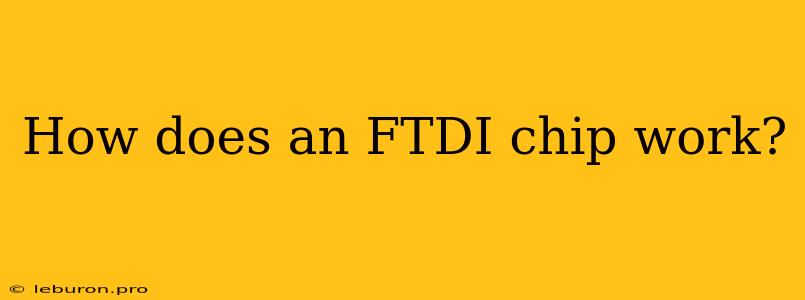FTDI chips are ubiquitous in the world of electronics, providing a simple and reliable way to connect devices to a computer. They bridge the gap between the complex protocols used by computers and the often simpler communication methods used by embedded systems. Their widespread adoption is a testament to their versatility and ease of use. But how do these chips actually work? This article will delve into the inner workings of FTDI chips, exploring their architecture, communication protocols, and the role they play in connecting devices to your computer.
Understanding the Basics: What is an FTDI Chip?
At its core, an FTDI chip acts as a USB-to-serial converter. It takes data sent from your computer over the USB bus and converts it into a serial data stream, which can then be understood by other devices. Conversely, it can take serial data from a device and convert it into USB data, making it accessible to your computer. This simple yet crucial functionality opens a wide range of possibilities for connecting various devices to your computer.
The Architecture of an FTDI Chip
FTDI chips employ a sophisticated architecture to handle the conversion process. At the heart of the chip lies a USB controller responsible for managing communication with the USB bus. This controller adheres to the USB specification, ensuring compatibility with the diverse range of USB devices available.
On the serial side, the FTDI chip uses a UART (Universal Asynchronous Receiver/Transmitter) to communicate with the external device. The UART is responsible for converting data between parallel and serial formats. It can send and receive data at various baud rates, which determine the speed of the data transfer.
Bridging the Gap: The Conversion Process
- USB Data Reception: When data arrives from your computer through the USB bus, it is received by the USB controller.
- Serial Data Formatting: The USB controller then passes the data to the UART, which transforms it into a serial format.
- Serial Transmission: The UART sends the formatted data to the external device through the serial interface.
This process is reversed for data coming from the external device:
- Serial Data Reception: The UART receives serial data from the external device.
- USB Data Formatting: The UART converts the serial data into a USB-compatible format.
- USB Transmission: The USB controller sends the data to the computer over the USB bus.
Communication Protocols: How FTDI Chips Speak
FTDI chips support various communication protocols, allowing them to connect to a broad range of devices. Some common protocols include:
- RS-232: This protocol is widely used for serial communication, often found in older devices.
- RS-485: This protocol is used for long-distance communication and is often employed in industrial applications.
- SPI: This protocol is a synchronous serial communication method frequently used in embedded systems.
- I2C: This protocol is a two-wire communication protocol commonly used in microcontrollers and sensors.
The specific protocol supported by an FTDI chip is determined by the model and the configuration options available. Some FTDI chips even offer multiple protocol support, allowing them to connect to devices using different communication methods.
The Benefits of Using an FTDI Chip
FTDI chips offer several key advantages for developers and users:
- Simplicity: They are incredibly easy to use. With minimal effort, you can connect a device to your computer and start exchanging data.
- Flexibility: Their support for various communication protocols makes them adaptable to different device types.
- Reliability: FTDI chips are known for their robust design and reliability, ensuring smooth data transmission.
- Cost-effectiveness: They are widely available and generally inexpensive, making them an attractive solution for many applications.
Applications of FTDI Chips
FTDI chips are used in a vast array of applications, encompassing various industries and fields. Some common uses include:
- Industrial Automation: Connecting sensors, actuators, and other industrial equipment to control systems.
- Robotics: Communicating with robotic arms, grippers, and other components.
- Medical Devices: Connecting medical equipment to computers for data logging, analysis, and control.
- Consumer Electronics: Connecting peripherals, such as keyboards, mice, and game controllers.
- Scientific Instrumentation: Communicating with scientific instruments for data acquisition and control.
Conclusion
FTDI chips have become indispensable in the world of electronics, bridging the gap between computers and a wide range of devices. Their ability to convert data between USB and serial formats, along with their support for multiple communication protocols, makes them a versatile and reliable solution for connecting devices to your computer. Whether you're an electronics hobbyist or a professional developer, understanding how FTDI chips work can unlock a world of possibilities for your projects.
